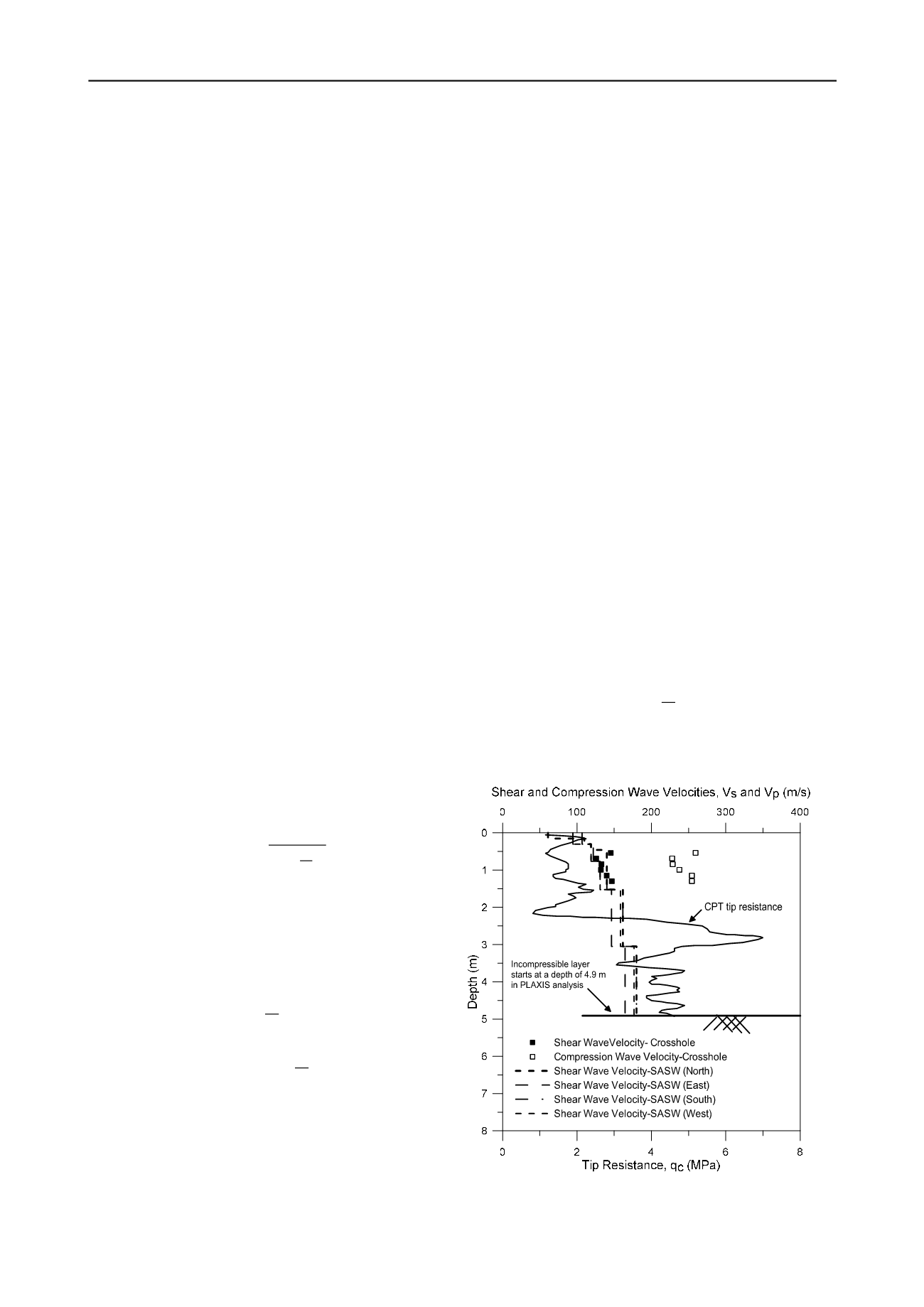
3468
Proceedings of the 18
th
International Conference on Soil Mechanics and Geotechnical Engineering, Paris 2013
2
SPT blow count and varied according to the calculated
relative strain levels. Lee and Salgado (2001) proposed a
model where soil stiffness is reduced based on the tolerable
settlements and relative density of the soil. A simplified
method was proposed by Lehane and Fahey (2002) which
takes the soil nonlinearity into account by reducing the
small-strain Young’s modulus with increasing axial strain.
None of these methods incorporate field seismic testing
to estimate soil stiffness near the base of footing where
much of the settlement occurs. In addition, none of the
methods considers the combined effects of shear strain level,
stress state and gradation on nonlinear stress-strain behavior
of granular soils. In this study, an approach implementing
dynamic nonlinear soil behavior and field seismic testing is
proposed to estimate the settlement of footings as discussed
below.
3 NONLINEAR BEHAVIOR OF GRANULAR SOIL
The stress-strain behavior of granular soil ranges from linear
(“elastic”) at small strains to highly nonlinear at large
strains. The shear strain below which the shear modulus is
constant is defined as the elastic threshold strain,
. For
granular soils with no plasticity,
varies with effective
confining pressure,
, and gradation, usually expressed by
the uniformity coefficient,
(Menq, 2003). For working
stresses associated with shallow foundations,
likely
ranges from 0.0001 to 0.003%. Advances in in-situ seismic
measurements, especially development of surface wave tests
like the Spectral-Analysis-of-Surface-Waves (SASW) test
(Stokoe et al.,1994), permit small-strain shear wave velocity
(V
s
) and shear modulus (G
max
) to be evaluated very near the
surface and in granular soils, even soils with gravel and
cobbles. Other dynamic laboratory testing methods, such as
the torsional resonant column, have made it possible to
investigate the nonlinear shear modulus of granular soils
over a wide strain range. For instance, Hardin and Drnevich
(1972) conducted the first comprehensive study of nonlinear
soil behavior and the parameters affecting nonlinearity.
They proposed a hyperbolic model to define nonlinear soil
behavior. This hyperbolic model was modified by Darendeli
(2001) based on a large dataset of combined resonant
column and torsional shear tests (RCTS) as follows:
⁄ = 1 1 +
(1)
where
=
curvature coefficient;
=
reference shear strain
at
⁄ =
0.5; and
is the shear modulus at shear
strain
=
. The value of the reference shear strain depends
on plasticity, confining pressure and overconsolidation ratio.
The modified hyperbolic model was further refined by Menq
(2003) for sands and gravels with no plasticity by defining
reference strain,
, and curvature coefficient,
, as follows:
= 0.12
.
.
.
(2a)
= 0.86 + 0.1log
(2b)
where
is in %;
=
uniformity coefficient;
=
mean
effective confining pressure in the same units as
;
and
=
reference mean effective confining pressure (1 atm).
A subroutine using the modified hyperbolic model
described by Equations 1 and 2 was written and
implemented in a commercially available finite element
program (PLAXIS). The subroutine uses a small-strain
reference shear modulus (discussed below and represented
by Equation 3) adjusted to the increasing stress state and the
G values in the G/G
max
-log
γ
relationship are adjusted to the
increasing shear strain level. The subroutine is used to
perform equivalent linear calculations (Kacar, 2013).
4 FIELD LOAD-SETTLEMENT TEST
To begin to develop a database of measured footing
settlements at granular sites with in-situ seismic and
nonlinear dynamic laboratory measurements, a small-scale
footing was constructed at a site in Austin, Texas. A detailed
geotechnical investigation was carried out at the site,
including soil sampling, cone penetration testing (CPT),
Spectral-Analysis-of-Surface-Waves (SASW) seismic tests,
and crosshole seismic tests.
4.1.
Soil Properties at Test Site
Based on standard laboratory tests, the soil at the field site is
a lightly overconsolidated, non-plastic silty sand with a
friction angle of 39 degrees and a cohesion of 6.1 kPa (likely
resulting from capillary stresses). Results from SASW and
crosshole seismic tests and CPT tests are presented in Figure
1. The friction ratio averages about 1.1% between depths of
0-2.1m and about 0.7% between depths of 2.1m-4.9 m.These
friction ratios are indicative of nonplastic granular soils
(Lunne et al., 2002). As seen in Figure 1, good agreement
exists between the crosshole and SASW results. Therefore,
the average V
s
profile from four SASW tests was used to
model the soil. With this profile and the average mass
density of the soil determined from intact samples (1.70
g/cm
3
), the small-strain shear modulus (G
max
) versus depth
profile before loading the footing was modeled as:
=
_
(3)
where
_
=
small-strain shear modulus at an
effective confining pressure of 1atm;
=
mean effective
Figure 1. In-situ seismic and CPT test results at the field site of the
load-settlement tests with a 0.91-m diameter footing


